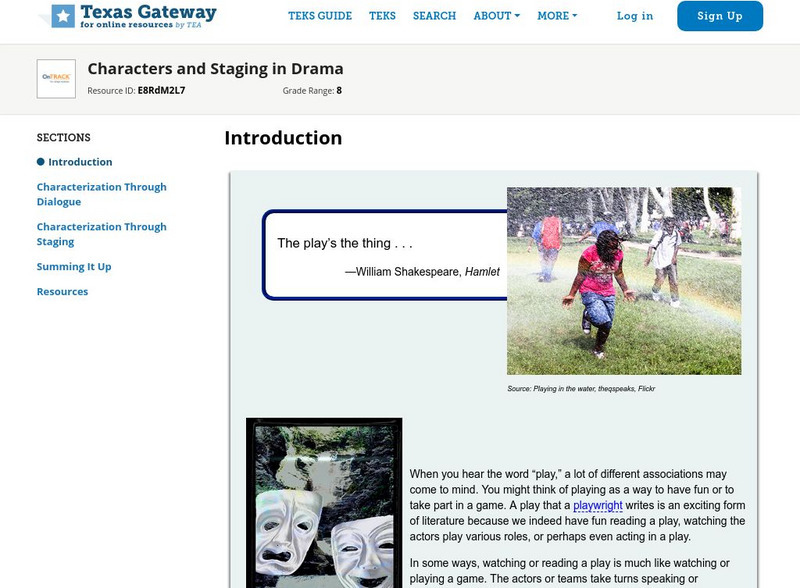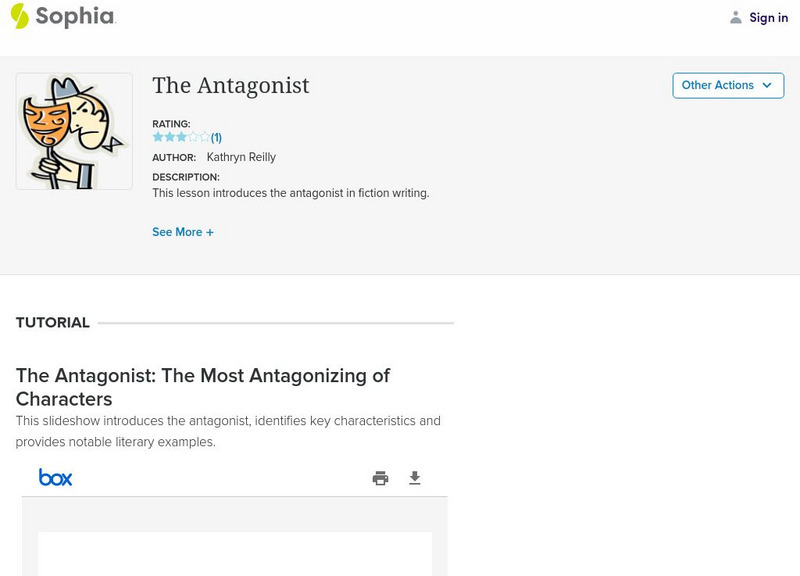Hi, what do you want to do?
Curated OER
Instill a Passion for Writing Short Stories
Quick writing tips and tricks to guide and polish learners' narrative writing.
Santa Ana Unified School District
Characters
Are your learners only talking about the plot of the story and not the richness of the characters? Then show them how important characters are to literature with the information available here. The learner will know how authors create...
Curated OER
Studying The American Musical Theatre
Students discover the group dynamics necessary to produce an American musical in this six day lesson. Themes and characterization techniques are explored during collaborative small group research projects.
Curated OER
Elements of Short Stories Vocabulary
For this literature worksheet, students match the correct word from the first column to the best definition found in the second column. There are twenty words and definitions to match.
Curated OER
B-movies and Plot: Story Elements, Writing, Media
Students use old "B-Movies" as a springboard to discuss and analyze traditional plot structures. They form groups and make their own 'movie' to demonstrate their knowledge.
Curated OER
"A Sound of Thunder" by Ray Bradbury: Questions
These questions are designed to accompany Ray Bradbury's "A Sound of Thunder," and could be used to guide and focus readers or as an assessment of reading skill and knowledge of the elements of a story. Page one focuses on questions of...
Curated OER
Creating with Alice
Students explore Alice Programming Software. In this exploratory lesson, students design a unique storyboard which will guide the creation of their Alice World. Students write and create their own films.
Curated OER
Create a Playbill!
Students examine the variety of elements for a written play and create a playbill. They read about and define literary elements on a worksheet, and participate in a dramatic reading. Each student then creates and publishes a playbill.
Curated OER
Ecology
Pupils personify ecology vocabulary and write a one-act play using their knowledge of ecology as the basis for characters, conflict, setting and plot.
Curated OER
Left to Their Own (Literary) Devices
Students write scenes for stories using their own original characters. However, they write using the literary and plot devices found in the Lemony Snicket book series.
Curated OER
Characterization Group Search
In this characterization worksheet, students identify the traits harbored by a character in a work of literature. Students work cooperatively to locate proof that the character exhibits these traits and then vote on the accuracy of...
Curated OER
Convincing Characters
Students create vivid, active characters for a story. In this character lesson, students discuss the characters in books they are familiar with. Students create a list of novels they have read and discuss the character types. Students...
Curated OER
Story Map
In this story map worksheet, students read a story and find the different story elements. They fill in the setting, characters, conflict, and climax.
Curated OER
Tattercoats
Pupils read the English folktale, "Tattercoats," identify basic literary terms, and respond to writing prompts. They compare and contrast with another Cinderella story version and create a graphic response to the story.
Curated OER
Building Relationships in a High School Classroom
High schoolers explore building new friendships during the first week of school. They participate in a variety of getting to know each other activities. Students work cooperatively and develop collegial relationships with their classmates.
Curated OER
Making Photo Essays Easy
Young scholars generate ideas about what makes a good story and a good photograph then place them together to create a photo essay. In this photo essay lesson, students assemble random photos into a story, select the best photos, and...
Curated OER
Book Chats
In this book chat learning exercise, students read a book and participate in a book chat for the novel. Students use the example questions to discuss the book. Students take turns asking each other questions as they participate in the...
Texas Education Agency
Texas Gateway: Characters and Staging in Drama
[Accessible by TX Educators. Free Registration/Login Required] In this lesson, you will analyze how different playwrights characterize, or develop, their protagonists and antagonists through the dialogue and staging of their plays.
Texas Education Agency
Texas Gateway: Characters and Staging in Drama
Learn how playwrights characterize their protagonists and antagonists through the dialogue and staging of their plays.
Texas Education Agency
Texas Gateway: Characters and Staging in Drama
[Accessible by TX Educators. Free Registration/Login Required] In this lesson, you will analyze how different playwrights characterize, or develop, their protagonists and antagonists through the dialogue and staging of their plays.
HotChalk
Hot Chalk: Lesson Plans Page: The Nature of the Antagonist
This lesson plan teaches students to understand the differences between protagonists and antagonists, to recognize a "villain" in storytelling, and to understand conflict as used in literature.
Read Works
Read Works: Character 4th Grade Unit
[Free Registration/Login Required] A three-lesson unit on characters where students learn about a story's protagonist and antagonist and the relationship between them by reading the book Hansel and Gretel by Rika Lesser. With free login,...
Georgia Department of Education
Ga Virtual Learning: Identify Plot: Plot Structure Diagram [Pdf]
This is a PDF of a ReadWriteThink plot structure diagram chart form for students to use on short stories. It includes exposition, rising action, climax, falling action, resolution, theme, and protagonist and antagonist.
Sophia Learning
Sophia: The Antagonist
This slideshow lesson focuses on the antagonist including defining the term, listing identifying characteristics, explaining the role of the antagonist, and providing a list of notable literary examples. It also offers links to lists of...



























